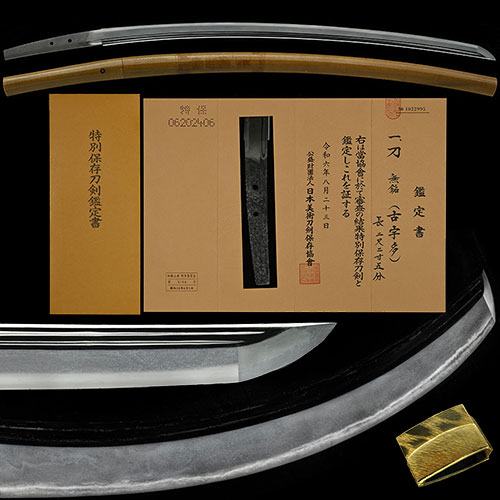
古宇多 刀 Kouda Katana
No.672915刀 古宇多 南北朝腰反りつく太刀姿 映り立ち葉が連れ二十刃風となり金筋砂流し頻りに掛る名品 二尺二寸五分Katana Kouda Nanbokucho period Koshizori-tsuku Tachi style, Utsuritachi You-tsure, Nijuba-style, Kinsuji and Sunagashi-shikirinikakaru, A masterpiece 68.2cm
- 極めKiwame
- 古宇多Kouda
- 登録証Registration
- 和歌山県 Wakayama 昭和28年6月5日 6/5/28(Showa)
- 時代Period
- 鎌倉末期から南北朝時代From the end of the Kamakura period to Nanbokucho period
- 法量Size
-
刃長 68.2cm 反り 2.4cm
元幅 3.0cm 先幅 2.0cm 元重 0.59cm 鎬厚 0.63cm 先重 0.45cm 鋒長 3.3cm 茎長 17.2cm 重量 614gHachou 68.2cm Sori 2.4cm
Moto-Haba 3.0cm Saki-Haba 2.0cm Moto-Kasane 0.59cm Shinogi-Thikess 0.63cm Saki-Kasane 0.45cm Kissaki-Chou 3.3cm Nakago-Chou 17.2cm Weight 614g - 国Country
- 大和Yamato
- 姿Shape
- 鎬造、庵棟、反り深く、腰反りつき、中鋒。Shinogidukuri, Iorimune, Deep Sori, Koshizori-tsuki, Chu-Kissaki
- 鍛Kitae
- 板目肌に、杢目肌交じり、地沸微塵につき、映りたつ。Itamehada, Mixed Mokumehada, Jinie entered finely, Utsuritatsu.
- 刃文Hamon
- 中直刃に、僅かに小互の目交じり、ほつれ・打ちのけ・二十刃頻りに掛り、湯走り掛り、小足・葉頻りに入り、小沸深くよくつき、金筋・沸筋・砂流し頻りに掛り、匂口明るい。Chu-Suguha, Slightly Mixed small-Gunome, Hotsure, Uchinoke, Nijuba shikirini-kakari, Yubashirikakari, Small-Ashi and You entered frequently, Small-Nie entered deeply, Kinsuji, Niesuji and Sunagashi shikirinikakari, Nioikuchi is bright.
- 帽子Boushi
- 乱れ込んで、火炎風に返る。Midarekonde, Kaen-style-Kaeru(Return to Kaen style.)
- 茎Nakago
- 大磨上、先切、鑢目勝手下り、目釘孔二。Ohsuriage, Sakikiri, Yasurime-kattesagari, Mekugiana are two(2)
- ハバキHabaki
- 金着二重。Double Kinkise
- 説明Drscription
- 宇多鍛冶は、鎌倉末期に祖古入道国光が、その子、国宗、国房等一族を引き連れ、大和宇陀より越中に移住したのに始まり、南北朝時代から室町時代に渡り繁栄している。その中でも南北朝期までの作を古宇多と呼称しているが、南北朝時代に入ると相州伝が加味されていく。この刀は、反り深く、腰反りつく鎌倉末期から南北朝初期の姿で、映りが立つ地鉄に、直刃調に、小互の目交じり、ほつれ・打ちのけ・湯走り・二十刃掛り、葉が連れて頻りに入り二十刃風となり、小沸深くつき、金筋・沸筋・砂流し頻りに掛るなど刃中よく働き、匂口明るく深い味いを呈す名品である。Uta Blacksmith began in the late Kamakura period when his ancestor Ko-nyu-dou Kunimitsu moved to Echichu from Yamato Uda with his children, Kunimune, Kunifusa and other families, and has prospered from the Nanbokuchou period to the Muromachi period.
Among them, the works up to the Nanbokucho period are called Kouda, but in the Nanbokucho period, Soshuden is added.
This sword has Deep Sori, Late Kamakura to early Nanboku-cho period with Koshizori-tsuku, Utsuritatsu with Jigane, Suguha-style, Mixed small-Gunome, Hotsure, Uchinoke, Yubashiri, Nijuba-kakari, You entered frequently, looks like Nijuba-style, Small-Nie entered deeply, Kinsuji and Niesuji, Sunagashi entered frequently, It works well in sword, Nioikuchi is bright and which profundity is felt.


